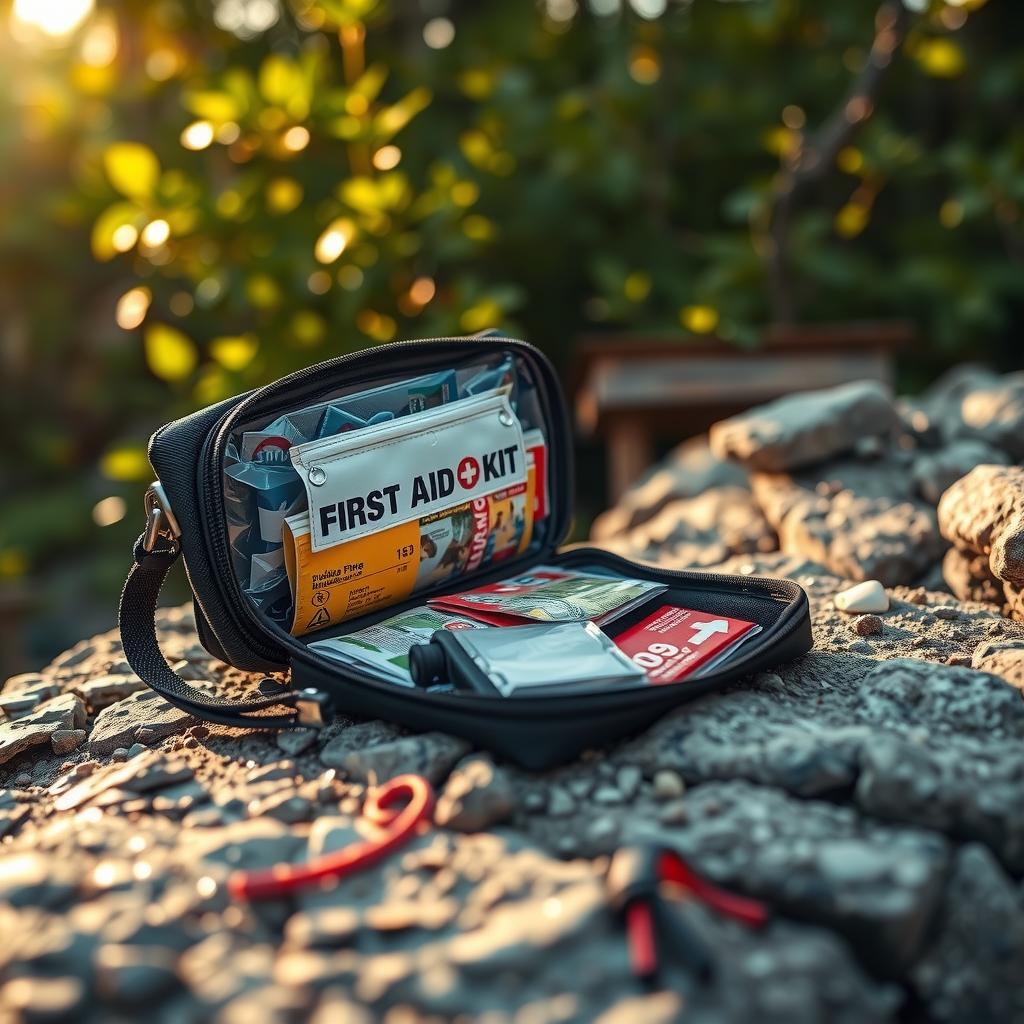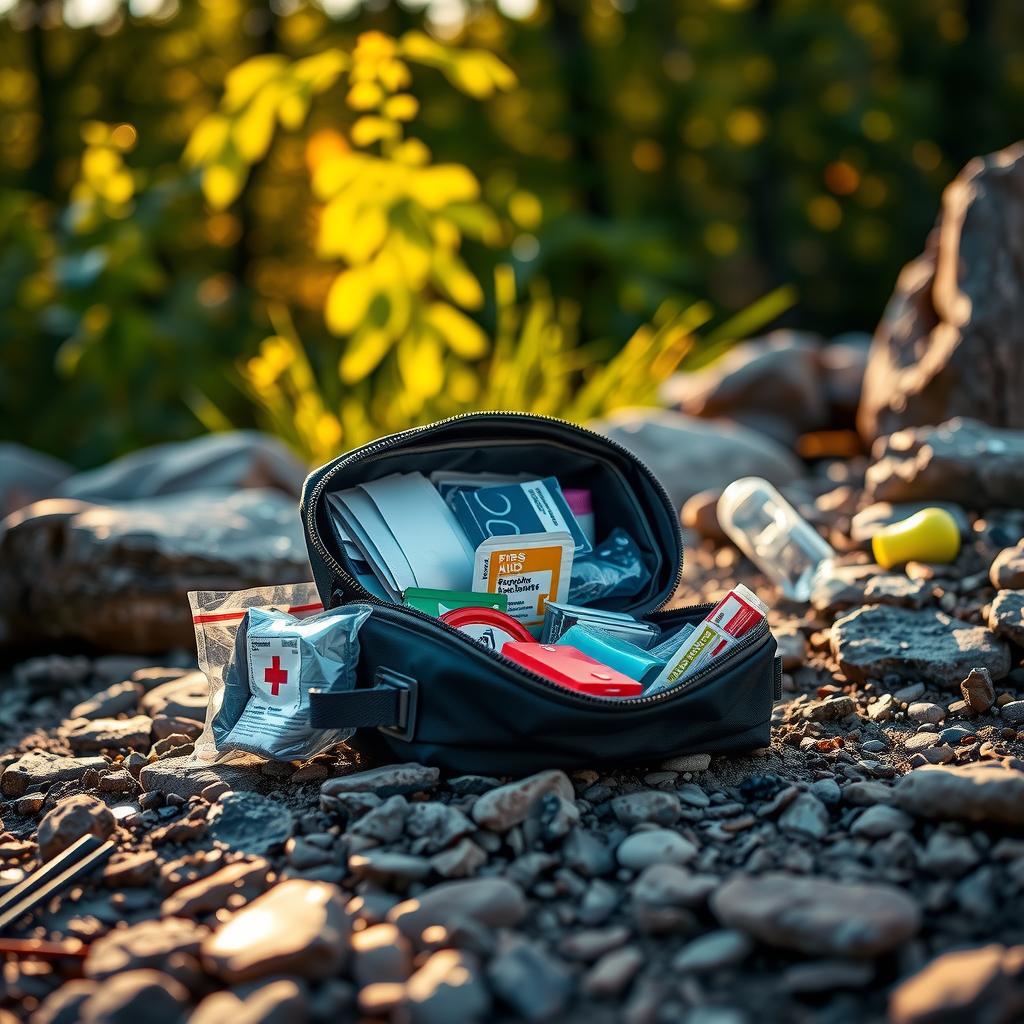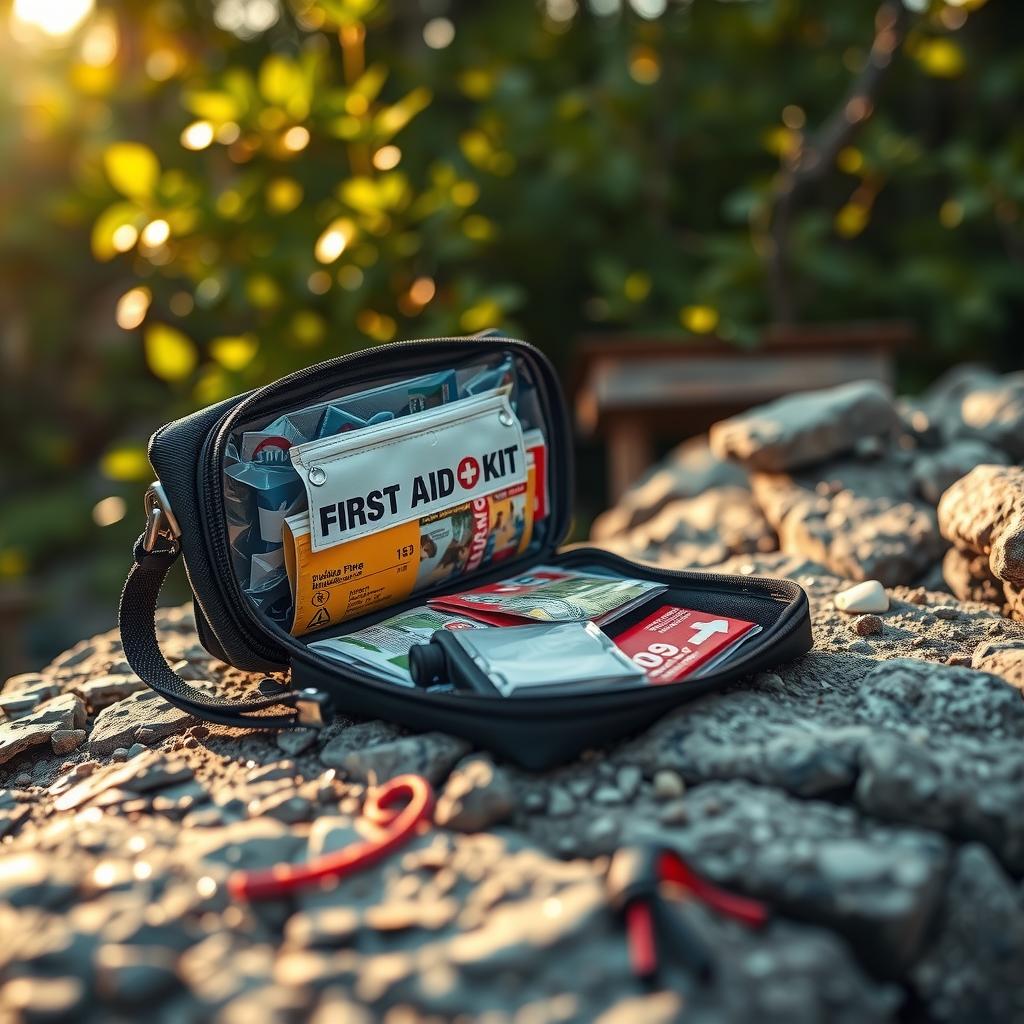When venturing into the great outdoors, what’s more crucial than ensuring safety? Picture this: a serene camping trip under the stars, only to be interrupted by an unexpected injury or emergency. This scenario underscores the necessity of being prepared with a reliable first aid kit, especially one tailored for waterproof camping conditions. In an environment where moisture and unpredictability reign supreme, having access to proper medical essentials can mean the difference between a minor inconvenience and a major crisis.
For outdoor enthusiasts, understanding the significance of a well-stocked first aid kit is paramount. It serves not just as a precaution but as an essential component of health preparedness when navigating through nature’s unpredictable terrain. A waterproof first aid kit ensures that all vital supplies remain protected from rain or accidental submersions in water bodies while hiking or fishing. The ability to respond quickly during emergencies is critical; hence selecting quality survival gear specifically designed for camping becomes indispensable.
Moreover, beyond mere convenience, investing in such specialized kits brings peace of mind to campers and adventurers alike. They contain emergency supplies curated for common injuries encountered during outdoor activities—from cuts and scrapes to insect bites and allergic reactions—ensuring readiness at every turn. Knowing that one has access to effective injury treatment allows individuals to fully immerse themselves in nature without constant worry about potential hazards.
Furthermore, recognizing how sudden accidents can occur even amidst leisure reinforces why every camper should prioritize their personal safety toolkit—especially when traveling off the beaten path where help may not be readily available. By arming oneself with an efficient travel first aid solution like a waterproof first aid kit, campers can feel empowered rather than exposed in unfamiliar environments.
As this article unfolds, readers will discover tips on assembling their custom waterproof first aid kits tailored specifically for camping adventures. From choosing appropriate containers that resist moisture penetration to selecting versatile medical essentials needed for various scenarios—this guide aims not only at informing but also equipping them with practical knowledge necessary for enhancing outdoor safety experiences. Whether they are seasoned explorers or weekend warriors, ensuring they have everything needed within reach transforms any excursion into safe exploration filled with memories rather than mishaps.

Key Points:
-
The Importance of a First Aid Kit: A comprehensive first aid kit is vital for outdoor enthusiasts to address common injuries encountered during camping trips, such as cuts and insect bites. Ensuring that this kit includes essential medical supplies can significantly enhance health preparedness in remote areas.
-
Waterproof Design Benefits: Opting for a waterproof first aid kit protects crucial emergency supplies from moisture, making it an indispensable part of any survival gear. This feature not only keeps the contents safe but also supports effective injury treatment regardless of weather conditions.
-
Knowledge and Accessibility: Having a well-organized first aid kit is only part of outdoor safety; understanding how to use its contents effectively is equally important. Campers should familiarize themselves with the medical essentials within their kits to be prepared for any situation they may face while enjoying nature’s beauty.

The Vital Role of a Waterproof First Aid Kit in Outdoor Adventures
Preparedness: A Key to Safety in Remote Locations
When venturing into the great outdoors, particularly in remote camping locations where immediate medical assistance is often scarce, the importance of having a well-equipped first aid kit cannot be overstated. Such environments can present unexpected challenges, from minor injuries like cuts and scrapes to more severe situations requiring urgent care. A quality waterproof first aid kit ensures that essential medical supplies remain dry and accessible regardless of weather conditions or environmental factors. In these scenarios, being prepared with comprehensive emergency supplies not only enhances safety but also fosters confidence among campers and adventurers.
Essential Components for Effective Injury Treatment
A well-rounded first aid kit should include an array of items tailored for various potential emergencies encountered while camping. These may consist of bandages, antiseptic wipes, gauze pads, adhesive tape, scissors, tweezers, and pain relievers—medical essentials that cater to common outdoor injuries such as abrasions or insect bites. Additionally, it’s prudent to incorporate specialized items like burn cream or allergy medication within the waterproof containment system. Notably, ensuring these supplies are organized within a durable waterproof case prevents water damage during rainstorms or accidental submersions when crossing streams—a frequent occurrence while exploring nature’s wonders.
The Significance of Health Preparedness
Health preparedness goes beyond just possessing equipment; it encompasses understanding how to utilize each component effectively during an emergency situation. Campers should take time before their trip to familiarize themselves with basic first-aid techniques related to injury treatment using their first aid kit. For instance, knowing how to clean wounds properly reduces infection risks substantially—an invaluable skill when far from civilization where professional medical help might be hours away. This knowledge empowers individuals with critical survival gear skills needed for maintaining health under challenging circumstances often faced in outdoor settings.
Building Confidence Through Knowledge
Equipping oneself with a comprehensive waterproof first aid kit is not merely about carrying supplies; it’s also about building confidence through preparation and education on health-related topics pertinent to outdoor experiences. Workshops on wilderness first-aid principles can serve as excellent resources for campers seeking further insights into handling real-life emergencies efficiently using their kits. By investing time into understanding both the contents and use-cases associated with this travel first-aid equipment prior to embarking on adventures ensures greater overall readiness against unforeseen events that could arise amidst nature’s unpredictability.
Conclusion: An Indispensable Tool for Outdoor Enthusiasts
In summary, whether one is hiking up rugged mountains or enjoying serene lakeside retreats as part of their camping experience—having a reliable waterproof first aid kit at hand forms an indispensable pillar supporting outdoor safety endeavors while fostering peace-of-mind amongst those who appreciate wild terrains’ beauty yet respect its inherent hazards too closely intertwined with adventure itself.
Essential Gear for Outdoor Safety
Building the Perfect Waterproof First Aid Kit
When venturing into the great outdoors, having a well-equipped and waterproof first aid kit is crucial for addressing common injuries that may occur during camping trips. A comprehensive first aid kit should include items specifically designed to treat cuts, scrapes, blisters, burns, and insect bites. At the core of this essential gear are adhesive bandages in various sizes to cover minor wounds effectively. Additionally, sterile gauze pads and medical tape are necessary for larger injuries or abrasions requiring more substantial coverage. For burns sustained from campfires or cooking equipment, it’s vital to include burn ointment and non-stick dressings to promote healing while preventing further irritation.
Equipping a first aid kit with antiseptic wipes or solutions ensures that all wounds can be cleaned properly before applying any dressing. This step is critical in preventing infection during outdoor adventures where access to clean water may be limited. Furthermore, consider adding tweezers for removing splinters or ticks—common nuisances on hiking trails—and scissors to cut gauze or clothing if needed. Insect bite relief cream will also enhance comfort when dealing with pesky bugs prevalent in many camping areas.
Preparing for Emergencies
In addition to basic supplies, a robust waterproof first aid kit must contain emergency items such as an emergency blanket which provides warmth in unexpected situations like hypothermia due to sudden weather changes at higher elevations. Pain relievers like ibuprofen or acetaminophen can help manage discomfort from various ailments including headaches caused by dehydration or altitude sickness—a potential risk in mountainous environments.
For those engaging in more adventurous activities such as rock climbing or mountain biking, incorporating specialized medical essentials tailored towards these sports could prove invaluable; elastic bandages provide support for strains and sprains while instant cold packs offer immediate relief from swelling after an injury occurs on the trail.
Health Preparedness While Camping
A well-rounded first aid kit also addresses health preparedness through maintaining a record of any personal medications required by campers within the group along with allergy information prominently displayed inside the case itself—this ensures quick access should an allergic reaction arise unexpectedly amidst nature’s allure.
Moreover, it’s beneficial when traveling abroad to tailor your travel first aid supplies accordingly since different regions may present unique challenges; understanding local flora can prevent adverse reactions due attributed exposure might influence what additional components merit inclusion within one’s waterproof first aid kit.
Planning ahead not only equips you but fosters confidence allowing adventurers peace of mind knowing they’re prepared adequately against unforeseen circumstances ensuring their focus remains on enjoying nature’s beauty rather than worrying about potential mishaps related directly back towards inadequate safety measures enacted beforehand!
Final Thoughts on Outdoor Injury Treatment
Ultimately investing time into assembling an effective waterproof first aid kit cultivates responsible outdoor safety practices prioritizing health preparedness throughout your journey whether embarking upon simple day hikes traversing less rigorous terrains versus multi-day excursions deep into secluded wilderness areas frequented solely by intrepid explorers seeking adrenaline-fueled experiences alike! It becomes evident how proper knowledge coupled alongside thoughtfully selected emergency supplies facilitates meaningful memory creation free from undue concern regarding mishandling minor injuries experienced throughout unforgettable moments shared amongst fellow nature enthusiasts engaged fully together celebrating life outside urban confines once again!
Effective Use of Your First Aid Kit
Empowering Safety in Nature Through Knowledge
Understanding how to effectively utilize a first aid kit is crucial for anyone venturing into the great outdoors. Whether camping, hiking, or simply enjoying a day at the beach, having quick access to emergency supplies can mean the difference between minor injuries and serious complications. A well-stocked first aid kit should contain medical essentials tailored for outdoor activities. This includes items like antiseptic wipes, adhesive bandages of various sizes, gauze pads, tape, tweezers, scissors, pain relievers such as ibuprofen or acetaminophen, and comprehensive instructions on injury treatment. By familiarizing oneself with these components before an outing begins—preferably during travel preparation—individuals can enhance their health preparedness significantly.
When selecting a first aid kit, consider opting for waterproof versions that can withstand the elements common during outdoor adventures. Rain or accidental immersion in water should not compromise vital supplies; thus investing in durable survival gear ensures that first responders have reliable resources at hand when emergencies arise. Moreover, it’s essential to regularly check and replenish any used items within your first aid kit. Over time medications may expire or supplies may dwindle; maintaining this readiness reflects proactive thinking about safety while enjoying nature.
Additionally, knowledge on how to treat specific injuries is equally important as having physical resources available. For example, understanding how to properly clean and dress wounds minimizes infection risks—a critical factor when dealing with cuts sustained from branches or tools while camping. Having knowledge about managing insect bites or allergic reactions also proves invaluable; knowing which antihistamines are included in one’s travel first aid inventory empowers individuals during unexpected encounters with wildlife.
In summary, effective use of a first aid kit hinges not only on its contents but also on the user’s familiarity with those items combined with practical skills related to emergency response situations encountered outdoors. The combination of quality equipment equipped within a thoughtful framework prepares individuals mentally and physically for adventures ahead while ensuring peace of mind throughout their journey into nature’s embrace.
By prioritizing outdoor safety through education surrounding one’s first aid kit, adventurers foster confidence that they are ready for whatever challenges they might face along their path—from treating minor scrapes acquired from rocky trails to addressing unforeseen medical issues that require immediate attention amid stunning landscapes away from civilization.
Frequently Asked Questions:
Q: What are the essential items that should be included in a waterproof first aid kit for camping?
A: A comprehensive first aid kit designed for camping should include medical essentials such as adhesive bandages, sterile gauze pads, antiseptic wipes, tweezers for splinter removal, and pain relievers. Additionally, it’s wise to have supplies specifically oriented towards common outdoor injuries like insect bite relief and burn ointment. Ensuring these items are housed within a waterproof first aid kit will help maintain their efficacy regardless of weather conditions.
Q: How can I ensure my first aid kit is truly waterproof?
A: When selecting a first aid kit, look for features such as sealed zippers or water-resistant materials that guarantee protection against moisture. Some kits come with additional watertight containers inside them to safeguard individual supplies further. Conducting periodic checks on your waterproof first aid kit will also help confirm that everything remains dry and usable when preparing for your next camping adventure.
Q: Why is it crucial to know how to use the contents of my first aid kit before going camping?
A: Simply possessing a first aid kit isn’t enough; understanding how to effectively utilize its contents is vital for effective injury treatment during emergencies. Familiarity with each item—such as knowing how to apply bandages correctly or when to use antiseptic wipes—contributes significantly to outdoor safety. This knowledge enhances health preparedness and ensures you can respond promptly and efficiently if an unexpected injury occurs while enjoying the great outdoors.

